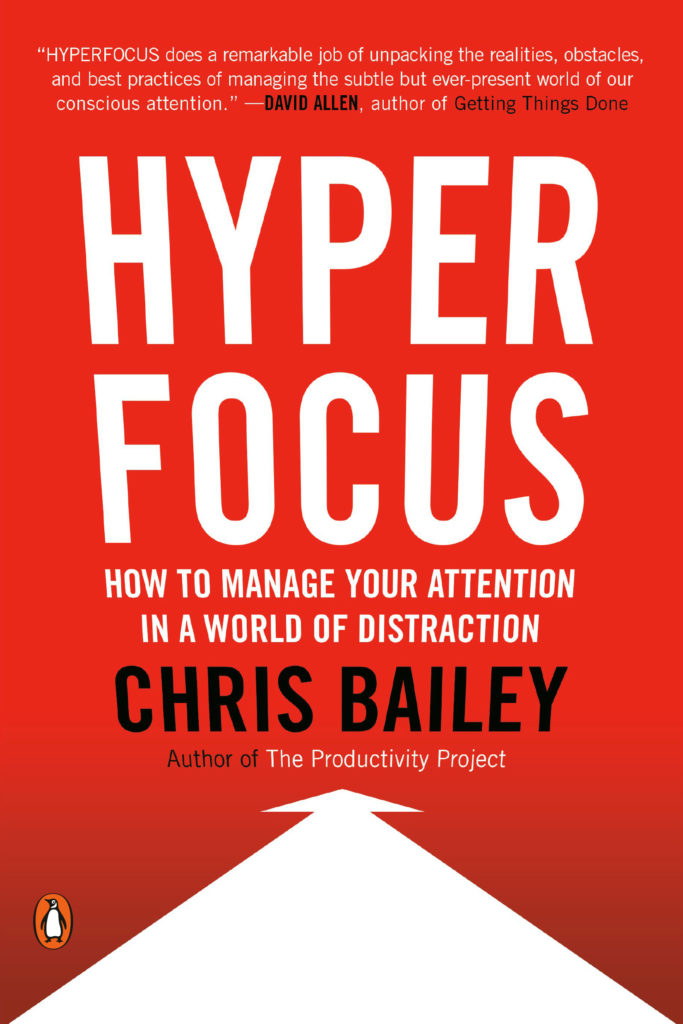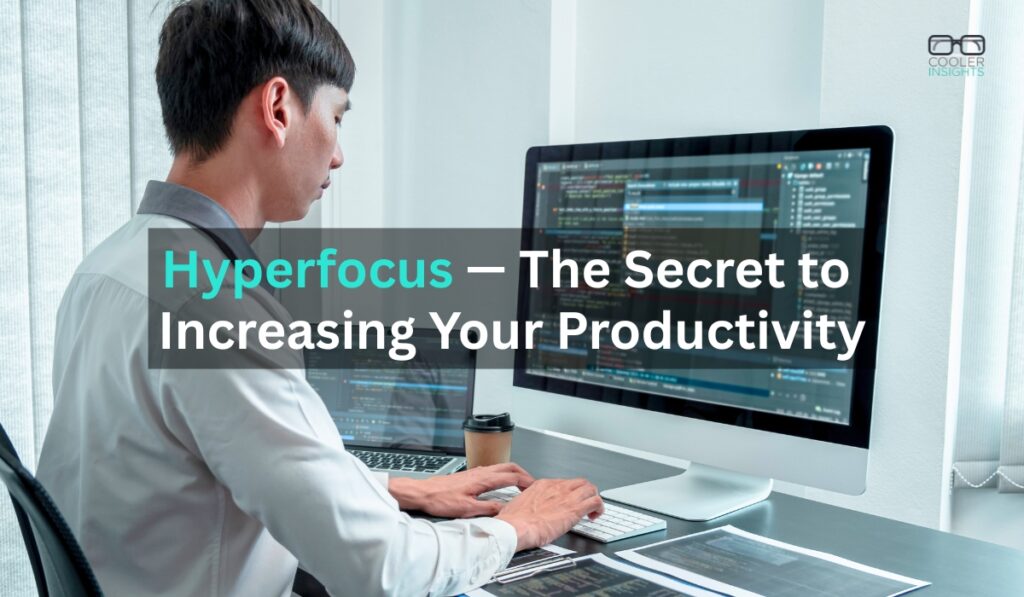
Need to boost your personal productivity? Start by focusing your attention on what matters.
Sadly, that’s not true for most of us. Studies show that we only work for 40 seconds in front of a computer before we’re interrupted!
In a world deluged by digital and physical distractions, focusing on the right thing at the right time matters.
But how do you even start?
Enter Hyperfocus: How to Be More Productive in a World of Distraction by personal productivity specialist Chris Bailey.
Drawn from years of experience and research, the book is a practical guide for anybody looking to get more stuff done at work or in their lives.
Let us look at some of the salient lessons from the book.
When Autopilot Mode is Bad News
I brush my teeth when I wake up in the morning. Thereafter, I’ll boil water to make my coffee, followed by going for my morning exercise. This is followed by cooling down while reading the morning papers, a quick shower, and then settling into the day’s activities.
This sequence repeats itself day in and day out. As much as 40 percent of our daily actions are done automatically without us thinking about them. Most of these can be multi-tasked if they’re simple tasks.
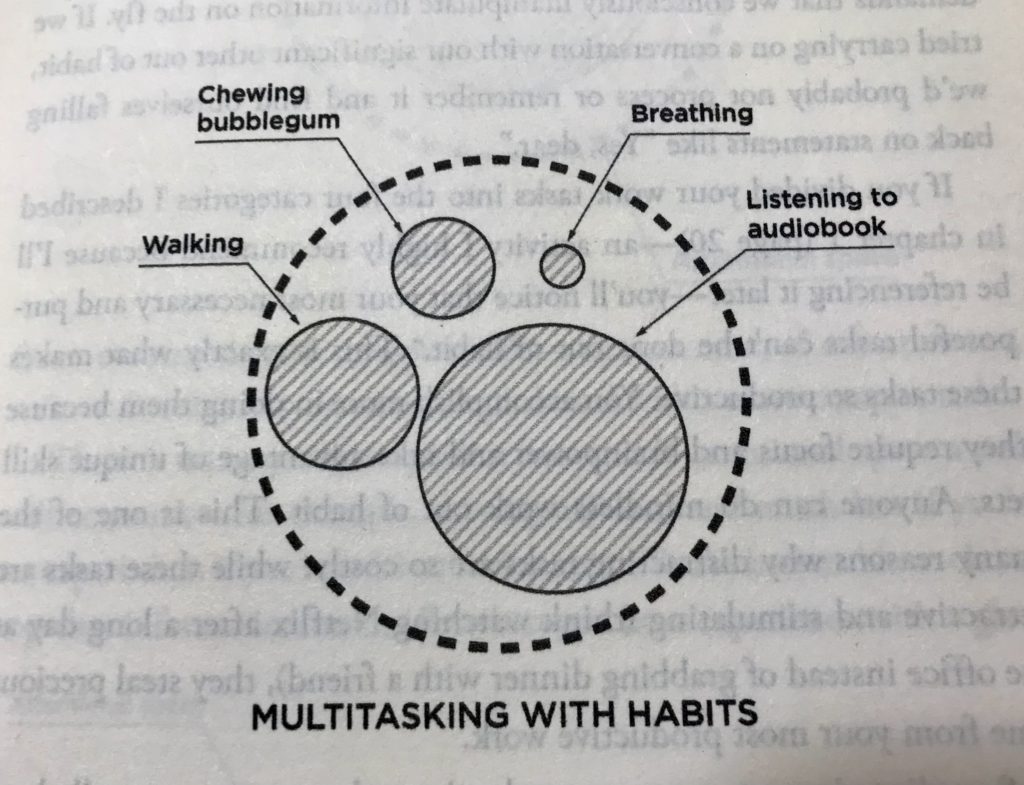
Courtesy of Hyperfocus book
Also known as habits, our autopilot mode can be useful in helping us do the right things. However, they can also trap us in a mindless loop of doom-scrolling through our smartphone apps, or binge-watching Netflix programmes.
To improve our productivity, we need to direct and sustain our attention on our most important tasks. These are what Bailey calls purposeful work which is both attractive and productive as shown below.
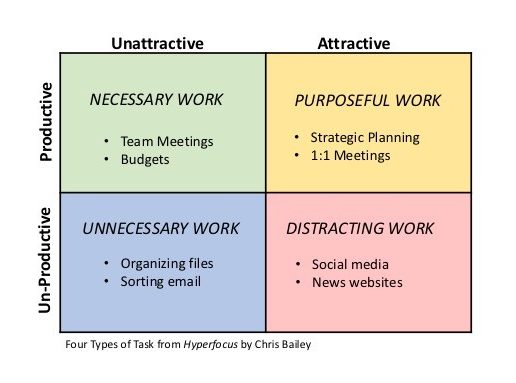
We would also need to put some time on necessary work, and try to reduce time on both unnecessary work (delegate or outsource), and distracting work (eliminate if possible).
The Importance of Intention
While we would love to do everything at the same time, we simply can’t due to the limits of our attention. Witness how often you’ve walked into your room but forgot why you went there in the first place.
Also known as attention overload, it is why you can’t multitask effectively when you have to do two or more complex tasks at the same time.
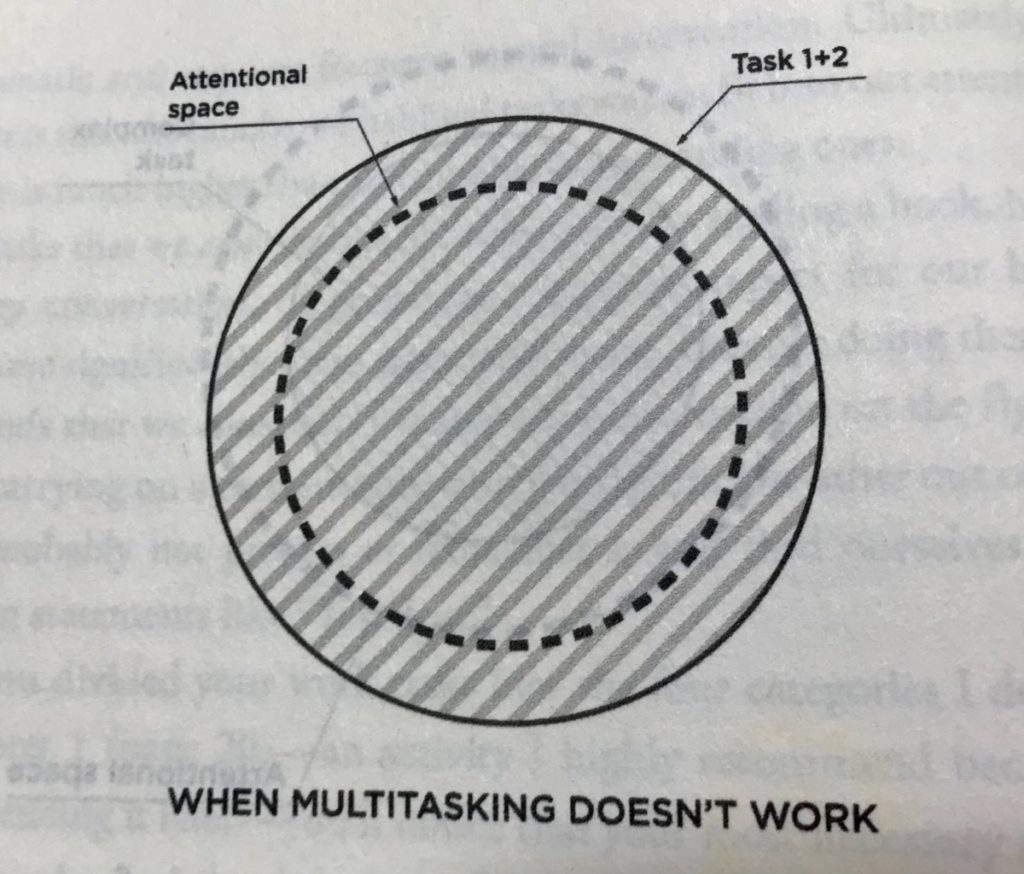
Courtesy of Hyperfocus book
Frequent task switching is also bad — a study cited by the book showed that our work takes 50 percent longer if we continually switch between tasks compared with doing one task from start to finish!
The solution? Choose what you do with intention. By setting your intentions more often, modifying your environment to be less distracting, and overcoming your resistance to certain tasks, you are much more likely to be productive.
The Value of Hyperfocus
Also known as a “flow” state, hyperfocus is the the result of activating your brain’s most productive mode. Hyperfocus happens when the task at hand completely fills your attentional space, a state where we are completely absorbed in a task while tuning out everything else.
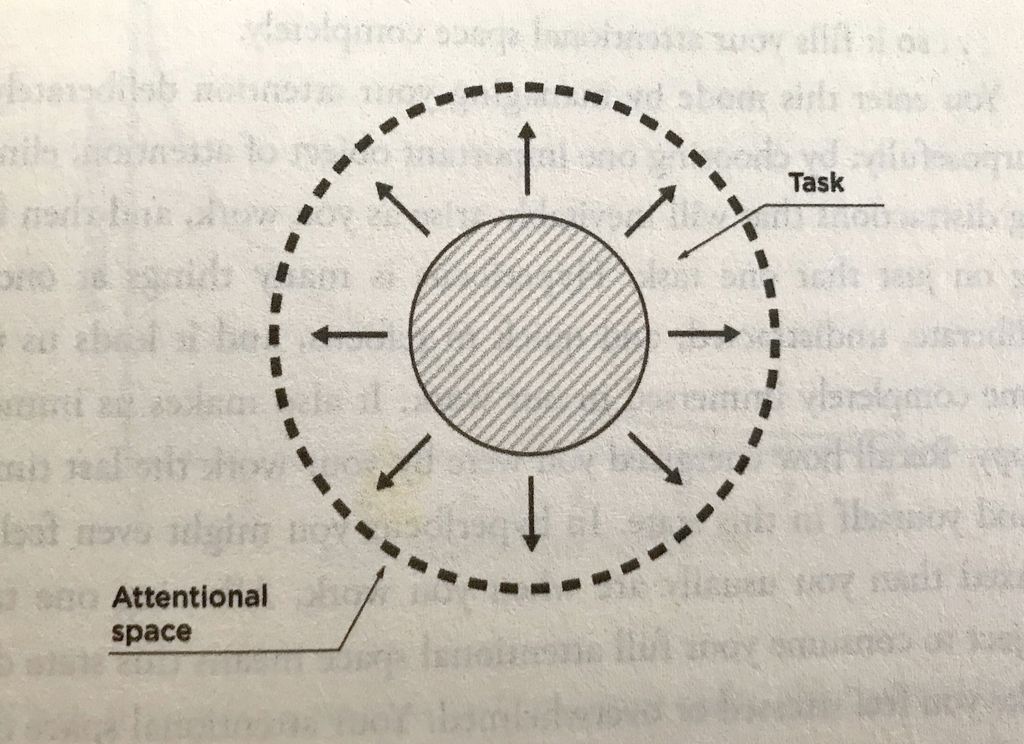
Courtesy of Hyperfocus book
You’ll “accomplish more in one hour of hyperfocus than in an entire day spent filling your attentional space to the brim with multiple—and often undeliberate—concerns.”
To do so means that you’ll need to whittle down the number of things you’re focusing on at any one time. The fewer things you pay attention to, the more productive you become.
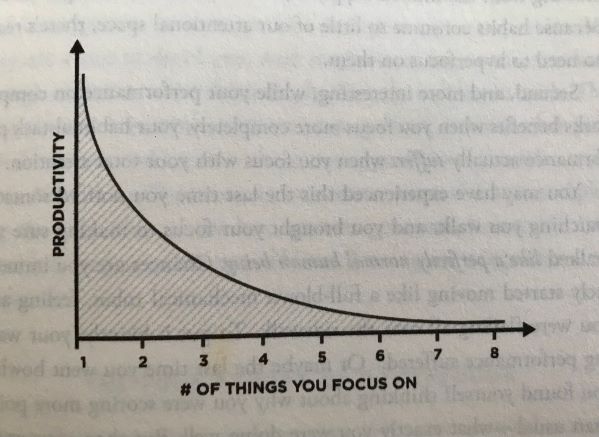
Courtesy of Hyperfocus book
The Four Stages of Hyperfocus
According to the book, there are four states that occur when we begin to focus:
- First, we’re focused and productive.
- Then, if we don’t get distracted or interrupted, our minds begin to wander
- Next, we make note of this mind wandering — this may take a while if we don’t check what is consuming our attentional space
- Finally, we shift our focus back to our original object of attention
To overcome this, we should apply the four stages of hyperfocus as shown below:
- Choose What To Focus On: Something meaningful or productive to engage our attention
- Eliminate Distractions: This should be both external and internal distractions
- Focus on Chosen Object of Attention: Don’t let anything else take its place!
- Continually Draw Your Focus Back to That Object of Attention: Find ways to bring your attention back, especially when your mind has wandered
Choosing What to Focus On
To be more intentional in how you spend your days, consider the following intention-setting rituals:
- Rule of 3: Determine what are the 3 things you need to achieve each day, and write them down. These can also be three weekly intentions.
- Most consequential tasks: List down what are your most consequential tasks
- Set hourly awareness chime: Do this as a reminder to regularly check in on what’s occupying your attentional space
- Be specific: The more detailed and specific your intention is, the better, eg “Set a bedtime alarm for 10 pm and when it goes off, start winding down.” instead of “Go to bed early.”
Dealing with Distractions
There are lots of distractions in our daily lives—from interruptions by colleagues or family members, to ubiquitous smartphone apps tempting us every minute. These can be classified into four types as shown in the book.
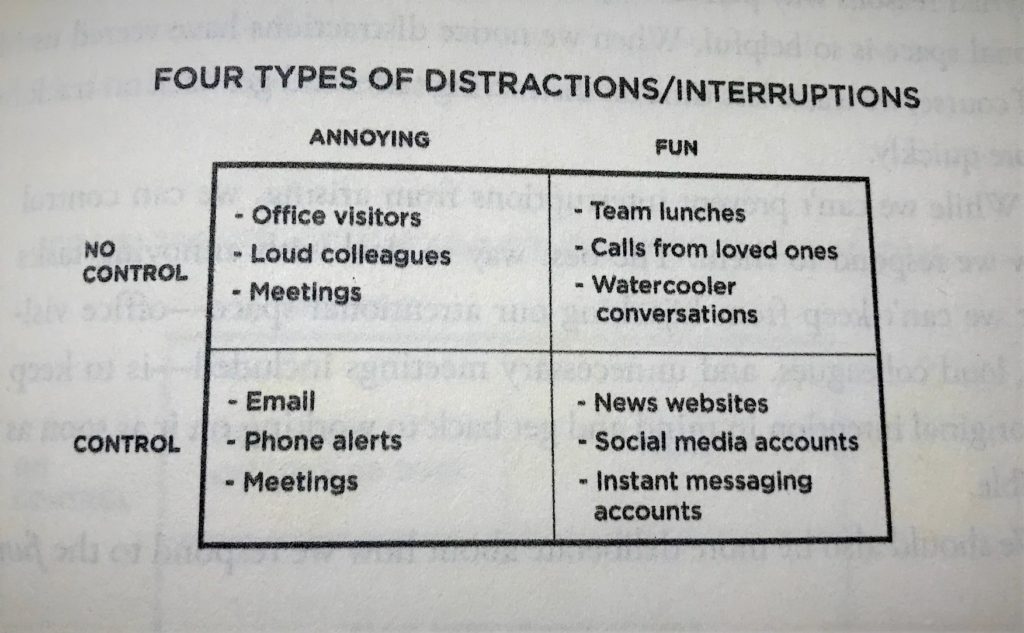
Courtesy of Hyperfocus book
To manage these distractions or interruptions, you can consider the following techniques:
- Annoying, No Control: From office visitors, loud colleagues to unnecessary meetings, find a way to deal with these quickly and then get back to track. For example, you can hang a “Do Not Disturb” sign, or put on noise-cancelling earphones for office visitors or loud colleagues.
- Fun, No Control: Just have fun and let loose during these periods. However, try to schedule them into your day, during your least productive periods (usually after lunch).
- Annoying or Fun, Control: In this case, you should find a way to manage both external and internal interruptions so that they do not interrupt you during your most productive periods.
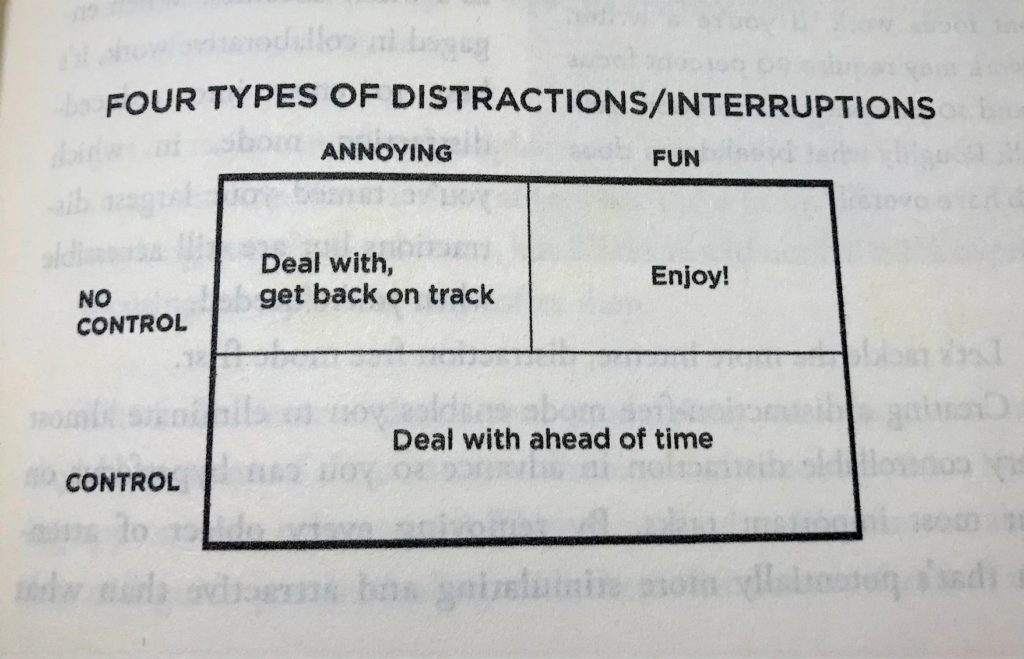
Courtesy of Hyperfocus book
Here are some strategies from the book on managing distractions:
- Use apps that cut you off from distractions (eg Freedom, Cold Turkey, RescueTime)
- Get out of the office (yes this works!)
- If you are the boss, create a distraction-free workplace for your team
- Switch off smartphone notifications (I do that—my only notification is when somebody calls me!)
- Use airplane mode when you are working
- Buy a second “distractions” device (eg like a tablet) and delete all other apps from your smartphone
- Prune your list of apps
- Schedule when you check your email
- Limit the number of points of contact
- Keep an external to-do list outside your email
- Ensure that all meetings have an agenda—and if your boss calls for one, ask him for it!
- Unplug from the Internet!
(Learn more about mimising digital distractions here.)
Making Hyperfocus a Habit
There are often times when our minds wander. When these happen, we need to address them:
- Feeling stressed or bored? Reduce the number of tasks to minimize attentional space overload;
- Work in a chaotic environment? Simplify our environment to reduce over-stimulation;
- Dealing with personal problems? Capture them down with a task-list, waiting-for list, or worry list so that these “open loops” do not remain as attention residues;
- Unsure if we’re working on the best thing? Work with intention to experience fewer feelings of doubt; and
- Too much unused attentional space? Deploy hyperfocus on our most complex tasks.
One of the ways to improve your hyperfocus is to embrace mindfulness and meditation.
For meditation, you can sit somewhere with your eyes closed and pay attention to your breath. A few minutes a day does wonders.
Mindfulness, on the other hand, is to intentionally be with a specific action for a minute of two. This can be simple tasks like sipping your coffee, washing dishes, or going for a walk. Notice the smells, tastes, feelings, thoughts, sounds, and sights, but do so without judgement. Merely focus on what you are perceiving, feeling or thinking in the present without being immersed in them.
Scatterfocus — A Way to Unleash Your Brain’s Creativity
While hyperfocus is your brain’s most productive mode, scatterfocus is its most creative. Here, the goal is to deliberately let your mind wander, but to do so in an intentional way.
By doing so, you’re more likely to come up with creative ideas as your mind wanders to the past (12 percent), present (28 percent), and future (48 percent) of the time.
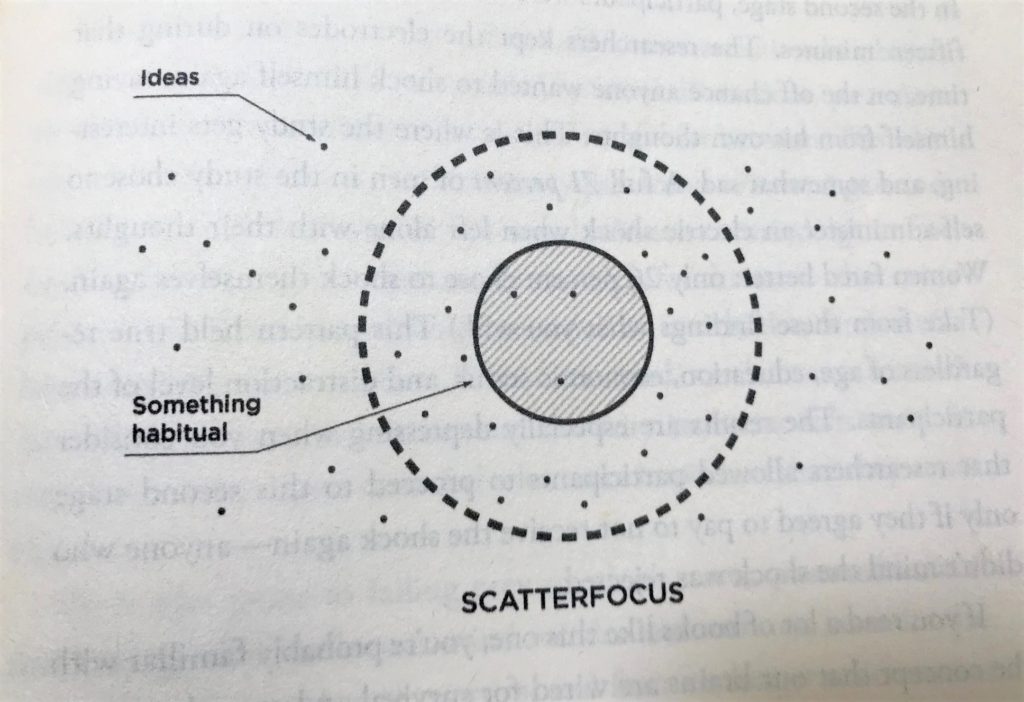
Courtesy of Hyperfocus book
(Note that scatterfocus isn’t about scrolling through TikTok videos, or bingeing on Netflix!)
There are three modes of scatterfocus that you should consider:
- Capture Mode: Let your mind roam freely and capture whatever comes up. Best for identifying what’s on your mind.
- Problem-crunching Mode: Hold a problem loosely in your mind, and let your thoughts wander around it. Best for mulling over specific problem.
- Habitual Mode: Engage in a simple task (eg walk in a park) and capture valuable ideas and plans that inevitably rise to the surface while doing it. Best for recharging and connecting greatest number of ideas.
Use Scatterfocus to Recharge Your Attention
Scatterfocus helps you to recharge your energy levels, and to reduce distractions or sidetracks.
You can make use of it by introducing refreshing work breaks that are…
- low in effort and habit-based;
- something that you like to do; and
- something that isn’t a chore (unless you enjoy doing that chore)
Examples may include going on a nature walk, running, visiting a gym, reading something fun and light, listening to music or an audiobook, spending time chatting with coworkers or friends, or a creative hobby like painting, crafting, photography, or cooking.
a) When to Take a Break?
Research shows that there are two rules:
- Take a break at least every 90 minutes
- Break for roughly 15 minutes for every hour of work that you do
b) Sleep as the Ultimate Break
By now, everybody knows the importance of sleep so I needn’t write too much about it.
To get more sleep, establish a quality bedtime ritual to unwind before you get to bed. Read, meditate, disconnect digitally, or drink a cup of herbal tea. Also make sure you get to bed at a decent hour.
6 Ways to Increase Creative Insights
To become more creative and to enrich your periods of scatterfocus, consider the following steps taken from the book:
- Scatter attention in richer environment: Choose a place where you’ll encounter new people, ideas, and sights.
- Write out problems you’re trying to crack: The more detailed you can document your problem, the better as your mind will continually process them in the background.
- Sleep on a problem: Sometimes your insights come during the REM (dream) stage of sleep.
- Step back: For complex and nonlinear problems, you may need to mix hyperfocus with scatterfocus. Purposefully delaying a creative decision may help your mind to make more valuable connections.
- Intentionally leave tasks unfinished: Yes, doing so may help you to continue processing that task in your mind. (See Zeigarnik effect.)
- Consume more valuable content: Be more deliberate in the information that you consume, and reduce trashy content in your info diet.
Conclusion
As an avid reader of personal development books, I found Hyperfocus pretty engaging and interesting. I like how it proposes that we split our time and energies between periods of hyperfocus and scatterfocus both at work and at play.
Having said that, I found that the book was a little disjointed at parts—it would be easier to follow if some of the key concepts (eg the four stages of hyperfocus) were carried through to implementation stages. Nevertheless, it was still a pretty engaging read, and the core concepts are easily applied.
Do you have a hyperfocus ritual and routine? What about an equivalent to scatterfocus, where you intentionally let your mind wander to generate creative ideas?
